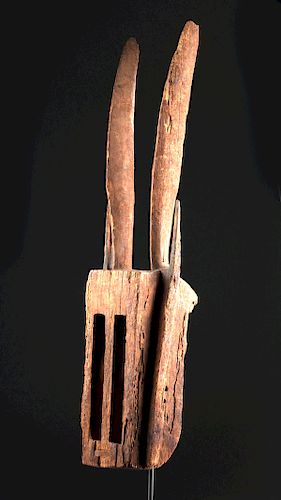Tall 20th C. African Dogon Wood Walu Mask - Antelope
Lot 68
About Seller
Artemis Fine Arts
686 S Taylor Ave, Ste 106
Louisville, CO 80027
United States
Selling antiquities, ancient and ethnographic art online since 1993, Artemis Gallery specializes in Classical Antiquities (Egyptian, Greek, Roman, Near Eastern), Asian, Pre-Columbian, African / Tribal / Oceanographic art. Our extensive inventory includes pottery, stone, metal, wood, glass and textil...Read more
Estimate:
$3,250 - $4,500
Absentee vs Live bid
Two ways to bid:
- Leave a max absentee bid and the platform will bid on your behalf up to your maximum bid during the live auction.
- Bid live during the auction and your bids will be submitted real-time to the auctioneer.
Bid Increments
| Price | Bid Increment |
|---|---|
| $0 | $25 |
| $300 | $50 |
| $1,000 | $100 |
| $2,000 | $250 |
| $5,000 | $500 |
| $10,000 | $1,000 |
| $20,000 | $2,500 |
| $50,000 | $5,000 |
| $100,000 | $10,000 |
| $200,000 | $20,000 |
About Auction
By Artemis Fine Arts
Oct 3, 2019
Set Reminder
2019-10-03 10:00:00
2019-10-03 10:00:00
America/New_York
Bidsquare
Bidsquare : Exceptional Day 2: Pre-Columbian & Tribal Art
https://www.bidsquare.com/auctions/artemis-gallery/exceptional-day-2-pre-columbian-tribal-art-4453
Day 2 of an important 2-day auction featuring exceptional, museum-worthy examples of Pre-Columbian from the ancient Americas, Native American, African / Tribal, Oceanic, Spanish Colonial and fossils. Artemis Fine Arts info@artemisgallery.com
Day 2 of an important 2-day auction featuring exceptional, museum-worthy examples of Pre-Columbian from the ancient Americas, Native American, African / Tribal, Oceanic, Spanish Colonial and fossils. Artemis Fine Arts info@artemisgallery.com
- Lot Description
West Africa, Mali, Dogon, ca. first half of the 20th century CE. A gorgeous hand-carved wooden mask depicting an antelope (known as a "walu" in Dogon). The rectangular mask presents with vertical eye channels on the front and narrow eye holes on the verso, a petite rectangular mouth above a short chin, thin ears projecting upwards along the periphery, and an enormous pair of horns with rounded tips. A pair of perforated suspension holes on either side of the mask enables additional ornamentation to drape from the face, and traces of several drilled holes along the verso would have enabled a large costume to be attached. Walu masks like this example are used by Dogon elders in the "dama," a commemorative ceremony for important elders in the community. Dozens of zoomorphic masks are paraded and danced by other members of the community as a symbolic means of protecting the honored elder from the negative effects of dark magic and death. A wondrous example from the Dogon! Size: 9.5" W x 37.25" H (24.1 cm x 94.6 cm); 47.125" H (119.7 cm) on included custom stand.
A stylistically-similar example of a larger size hammered for $4,500 at Sotheby's, New York "African & Oceanic Art" auction (November 11, 2005, lot 41): https://www.sothebys.com/en/auctions/ecatalogue/2005/african-oceanic-art-n08132/lot.41.html
For another example of a different style of Walu mask, please see The Metropolitan Museum of Art, accession number 1979.541.7: https://www.metmuseum.org/art/collection/search/314148
Provenance: private New York, New York, USA collection
All items legal to buy/sell under U.S. Statute covering cultural patrimony Code 2600, CHAPTER 14, and are guaranteed to be as described or your money back.
A Certificate of Authenticity will accompany all winning bids.
We ship worldwide and handle all shipping in-house for your convenience.
#149217Repair to one horn near top of head, with chips and light adhesive residue along break lines. Losses to areas of face, ears, chin, peripheries, and verso as shown. Chips to multiple areas of face, peripheries, and verso, with light encrustations, several stable fissures, and extensive insect damage. Nice earthen deposits and patina throughout.Condition
- Shipping Info
-
All shipping is handled in-house for your convenience. Your invoice from Artemis Gallery will include shipping calculation instructions. If in doubt, please inquire BEFORE bidding for estimated shipping costs for individual items.
-
- Buyer's Premium



 EUR
EUR CAD
CAD AUD
AUD GBP
GBP MXN
MXN HKD
HKD CNY
CNY MYR
MYR SEK
SEK SGD
SGD CHF
CHF THB
THB














